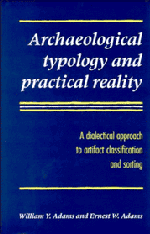 Archaeological Typology and Practical Reality
Archaeological Typology and Practical Reality Book contents
- Frontmatter
- Contents
- List of figures
- List of tables
- The archaeologist's preface
- The philosopher's preface
- PART I Introductory
- PART II The nature of types and typologies
- 3 Dimensions and elements of “typehood”
- 4 Perceptual and conceptual foundations
- 5 The dialectics of type formulation
- 6 The nature of types
- 7 The structure of typologies
- 8 A synthetic definition of typology and type
- PART III Typology in action: the Medieval Nubian Pottery Typology
- PART IV Pragmatics of archaeological typology
- PART V Classification, explanation, and theory
- Appendices
- References
- Index
7 - The structure of typologies
Published online by Cambridge University Press: 23 November 2009
- Frontmatter
- Contents
- List of figures
- List of tables
- The archaeologist's preface
- The philosopher's preface
- PART I Introductory
- PART II The nature of types and typologies
- 3 Dimensions and elements of “typehood”
- 4 Perceptual and conceptual foundations
- 5 The dialectics of type formulation
- 6 The nature of types
- 7 The structure of typologies
- 8 A synthetic definition of typology and type
- PART III Typology in action: the Medieval Nubian Pottery Typology
- PART IV Pragmatics of archaeological typology
- PART V Classification, explanation, and theory
- Appendices
- References
- Index
Summary
In Chapter 3 we made the point that a lexicon is a congeries of words, a classification is a set of classes, but a typology is a system of types. What we mean by this is that a typology has systemic or structural features that are not entirely dictated by the nature of the constituent types, just as a language has structural features that are not dictated by its lexicon (cf. Waugh 1976: 20). In this chapter we will consider first what are the structural features of a typology, and then how they come about and what (if any) purpose they serve. The features that we will specifically discuss are those of boundedness and comprehensiveness of the typology itself, and the mutual exclusiveness, consistency of definition, equivalence, equidistance, and independence of the constituent types.
Basic structural features
Boundedness. In any classification that is to be used for sorting entities (that is to say, a typology), it must be clear at the outset what is and is not to be sorted. Hence typologies (unlike some other classifications) have quite rigidly specified and inflexible boundaries. Moreover, because sorted material is often subjected to statistical manipulations, the outer boundaries of the system cannot be adjusted to include new material which was formerly excluded, without invalidating any statistical operations that were previously performed.
Typological boundaries may be defined on the basis of either internal or external criteria, or both (see Chapter 14).
- Type
- Chapter
- Information
- Archaeological Typology and Practical RealityA Dialectical Approach to Artifact Classification and Sorting, pp. 76 - 90Publisher: Cambridge University PressPrint publication year: 1991


